Birds of the Canary Islands are an incredibly diverse group of avians consisting of various colorful species.
The islands are home to over 200 species of birds, including both endemic and migratory species, making it one of the best places in the world for bird watching.
These birds are unique and attractive, from the sombrero-clad Canarian Chiffchaff to the bright and beautiful Atlantic Canary.
The Canary Islands are a true paradise for bird lovers, offering stunning views of soaring raptors, vibrant songbirds, and various waterfowl. Whether you’re a beginner or an experienced birdwatcher, the Canary Islands will have something to offer.
14 Birds to Watch in Canar
The Canary Islands are a group of seven islands located in the Atlantic Ocean, off the coast of Africa. They are part of Spain but have a distinct culture and history. The islands are known for their volcanic landscapes, subtropical climate, and rich biodiversity.
Here are 14 birds that you can watch in the Canary Islands
1. Berthelot’s Pipit
Berthelot’s pipit is a small passerine bird, meaning it belongs to the group of small perching birds. It is commonly found year-round in the Madeira and Canary Islands in these archipelagos.
This bird species inhabits open country areas, such as fields or grasslands. Its nest is typically built on the ground and contains 3-5 eggs. Berthelot’s pipit is a small bird, measuring 13-14 centimeters.
It is easily identified by its yellowish-brown feathers, white underparts, and white eyebrow lines.
| Kingdom | Animalia |
| Phylum | Chordata |
| Class | Aves |
| Order | Passeriformes |
| Family | Motacillidae |
| Genus | Anthus |
| Species | A. berthelotii |
2. Blue Chaffinch
The Tenerife blue chaffinch is an incredibly unique species of bird. It belongs to the family of finches known as Fringillidae, found only in the Canary Islands of Spain.
This bird is endemic to the island of Tenerife, meaning it is native to this island and nowhere else in the world.
It is an iconic species recognized as the island’s natural symbol, along with the Canary Islands dragon tree. The Tenerife blue chaffinch is a medium-sized bird with distinctive blue-gray plumage and a yellow belly.
It is known to have a loud, clear call that can be heard up to several kilometers away. Its diet mainly consists of insects, spiders, and other small invertebrates.
The species also feeds on fruits, grains, and nectar. The Tenerife blue chaffinch is a beloved species to many and is a popular bird-watching attraction in the Canary Islands. It has also been featured on many stamps and postal cards as a symbol of the region.
Unfortunately, the species faces threats due to habitat destruction and loss of food sources. This has led to a drastic decrease in the population size of this species, making it a critically endangered species.
Conservation efforts are needed to ensure that this species does not become extinct.
| Kingdom | Animalia |
| Phylum | Chordata |
| Class | Aves |
| Order | Passeriformes |
| Family | Fringillidae |
| Genus | Fringilla |
| Species | F. teydea |
3. Ring-billed Gull
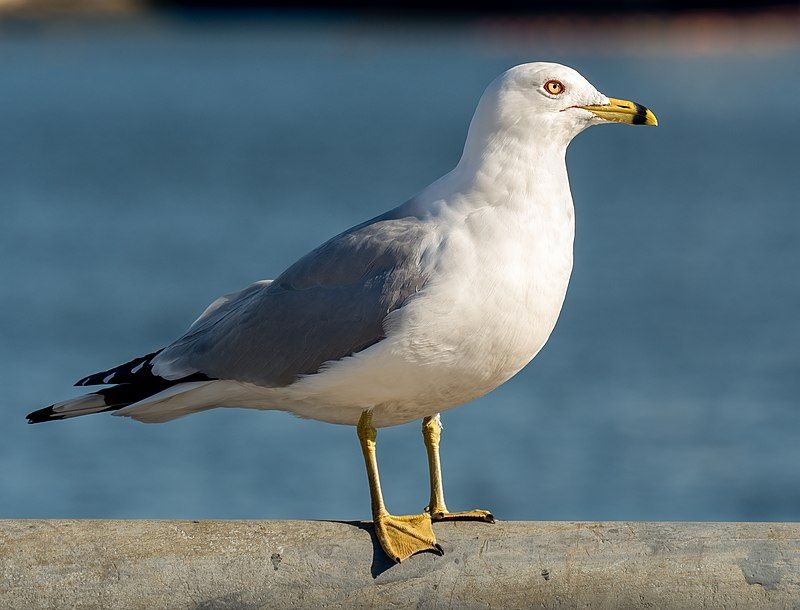
The ring-billed gull is a species of gull that is found in North America. It is a medium-sized bird with a wingspan of around 18 inches and a length of around 13 inches. Its genus name, Larus, is derived from Latin and translates to “gull” or “large seabird.”
The specific name, delawarensis, refers to the Delaware River where the species is found. This gull species can be found along the coasts of the Great Lakes, the Atlantic coast, and the Pacific coast.
It is a migratory species and can be seen in large numbers during migration season. It feeds on insects, fish, and other small animals. Its distinctive ring-shaped bill grabs food from the water’s surface.
The ring-billed gull is a common sight along the coastlines of North America and is a species of most minor concern.
| Kingdom | Animalia |
| Phylum | Chordata |
| Class | Aves |
| Order | Charadriiformes |
| Family | Laridae |
| Genus | Larus |
| Species | L. delawarensis |
4. Bolle’s Pigeon
Bolle’s pigeon is a dove species native to the Canary Islands of Spain. It is part of the Columbidae family’s Columba genus, including doves and pigeons.
The bird is named after the German naturalist Carl Bolle, who was the first to separate it from the laurel pigeon. Bolle’s pigeon is also known as Bolle’s laurel pigeon or dark-tailed laurel pigeon and is identified by its dark gray plumage and long tail.
It is an endemic species, meaning it is only found in specific regions and not elsewhere. The adult bird has a wingspan of about 30–40 cm and weighs around 160–200g. The birds feed on seeds, buds, and fruits and live in pairs or small groups.
They breed in the Canary Islands in the summertime and nest in rocky areas. Bolle’s pigeon is considered near-threatened due to habitat loss and hunting.
Conservation efforts are being taken to protect the species and ensure its continued existence in the Canary Islands.
| Kingdom | Animalia |
| Phylum | Chordata |
| Class | Aves |
| Order | Columbiformes |
| Family | Columbidae |
| Genus | Columba |
| Species | C. bollii |
5. Common Pochard
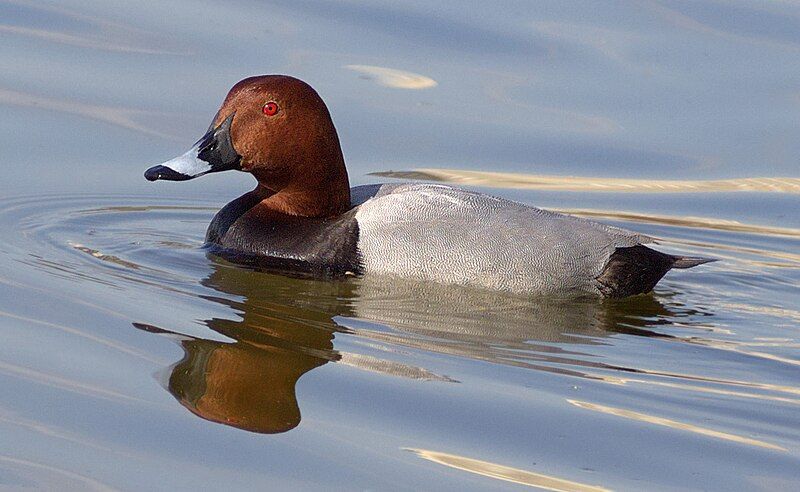
The common pochard is a medium-sized diving duck found in many parts of the world. The bird’s scientific name, Aythya ferina, is derived from two sources.
The first source is Greek Lithuania, an unidentified seabird mentioned by authors such as Hesychius and Aristotle. The second source is the Latin feria, meaning “wild game.” This is derived from a virus, the Latin word for “wild.”
Combining these two sources gives the scientific name of the common pochard a solid connection to wild nature. The common pochard is a resilient bird found in many habitats, such as wetlands, lakes, and ponds.
It is a strong swimmer known to dive deep underwater to catch fish. Its diet mainly consists of aquatic insects, small fish, and plants. The common pochard is a migratory species found in large flocks in the winter months.
The common pochard has a distinct appearance and is easily recognizable. Its head and neck are deep chestnut with a white ring around it. The back and wings are brownish-black with white specks. Its chest is white, and its belly is light gray.
Its legs and feet are black. The common pochard has a special place in many cultures. In Hinduism, it is associated with the god Vishnu and is seen as a symbol of fertility. In China, it is a symbol of good luck and abundance.
It is also Ethiopia’s national bird and a symbol of freedom and peace. The common pochard is a species that is both beautiful and resilient. It is a species closely associated with wild nature, and it has special meaning in many cultures worldwide.
| Kingdom | Animalia |
| Phylum | Chordata |
| Class | Aves |
| Order | Anseriformes |
| Family | Anatidae |
| Genus | Aythya |
| Species | A. ferina |
6. Eurasian Wigeon
The Eurasian wigeon is a species of dabbling duck, a genus of waterfowl in the family Anatidae. It is also known as the European wigeon, the widgeon, or the wigeon. It is one of three species of wigeon, the other two being American and Chiloé.
The Eurasian wigeon is a widespread species throughout the Palearctic region, spanning Europe, Asia, and North Africa. It is common in wetlands, marshes, and shallow lakes, where it feeds on aquatic vegetation.
During the winter, the Eurasian wigeon migrates south to warmer climates, with some birds even reaching the northern coast of Africa. The Eurasian wigeon is easily identifiable due to its distinctive plumage.
It has a grey-brown head and neck, a chestnut-colored breast, and a white belly. Its wings are also marked with white, black, and chestnut patches. The male has a green head and a white stripe running along its face.
The Eurasian wigeon is an essential species in many regions, providing food and recreation for humans and habitat for other wildlife. It is also an important indicator of wetland health, and its presence can help determine the local environment’s health.
Its populations are monitored closely, and conservation efforts are in place to ensure its survival for future generations.
| Kingdom | Animalia |
| Phylum | Chordata |
| Class | Aves |
| Order | Anseriformes |
| Family | Anatidae |
| Genus | Mareca |
| Species | M. penelope |
7. Eurasian Chaffinch
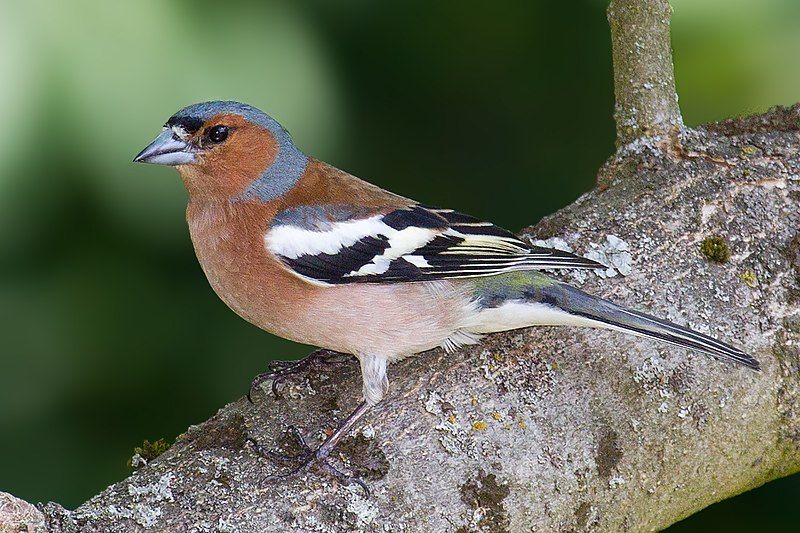
The Eurasian chaffinch, commonly called the chaffinch, is a small passerine bird in the finch family. It is widely distributed and can be found in many parts of Europe, Asia, and North Africa. The male chaffinch is easily recognizable due to its distinctive coloration.
It has a blue-grey cap and rust-red underparts, making it stand out from other species of birds. Its body is small and plump, with a short, conical bill and a medium-length tail. The wings are dark brown above and white underneath, with white spotting.
The legs and feet are pinkish-brown. The female chaffinch is duller in color and lacks the bright blue-grey cap of the male. Both sexes have a white throat patch and a black bib on their chest.
The chaffinch is known for its melodious song and can often be heard singing from trees and shrubs. It feeds mainly on insects, berries, and seeds and can usually be seen hopping on the ground for food.
| Kingdom | Animalia |
| Phylum | Chordata |
| Class | Aves |
| Order | Passeriformes |
| Family | Fringillidae |
| Genus | Fringilla |
| Species | F. coelebs |
8. Oystercatchers
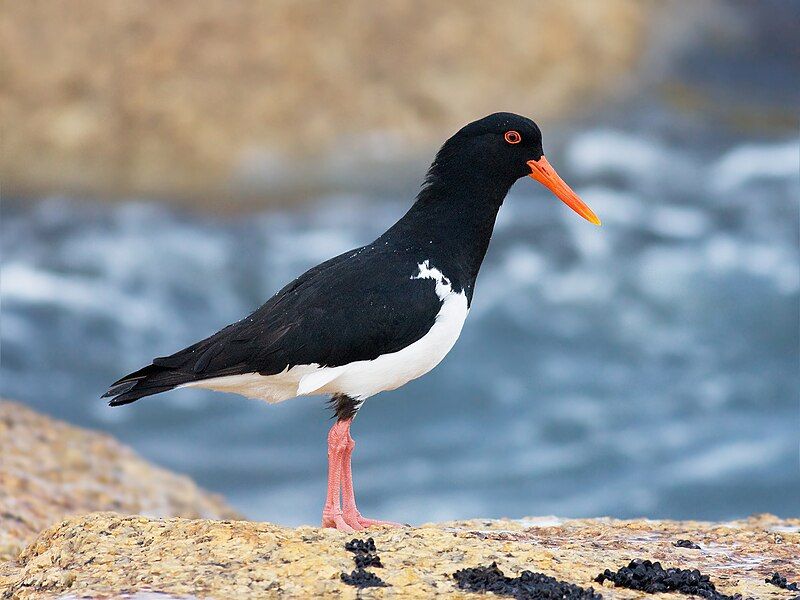
The oystercatchers are a type of wading bird belonging to the family Haematopodidae. This family is the only one to contain the single genus Haematopus, which comprises all the oystercatcher species.
Oystercatchers can be found in coastal areas worldwide, except in the polar regions and certain parts of Africa and Southeast Asia. Oystercatchers are known for their long, bright orange beaks and striking black and white plumage.
They are highly adapted to life in the intertidal zone, the area between land and sea, and they feed mainly on mollusks, worms, crustaceans, and other small marine creatures.
They have long legs and sharp claws that help them walk in shallow waters to find food. Their diet also includes some plant materials, such as seaweed. Oystercatchers are very social birds and usually form large flocks.
These flocks may contain hundreds of birds and protect against predators.
In addition, the birds use their distinctive calls to keep in contact with each other and form a bond between members of the flock. Oystercatchers are an essential part of the ecosystem in coastal areas, as their large numbers help keep the prey population in check.
They also provide an essential food source for other animals, such as foxes and other birds of prey. The oystercatcher is a species of conservation concern, and their habitats must be protected to maintain healthy populations of this unique bird.
| Kingdom | Animalia |
| Phylum | Chordata |
| Class | Aves |
| Order | Charadriiformes |
| Family | Haematopodidae |
| Genus | Haematopus |
9. Canary Islands Stonechat
The Canary Islands stonechat is a species of bird found exclusively on the island of Fuerteventura, located off the coast of Africa in the Canary Islands.
It is also referred to as the Fuerteventura Stonechat or Fuerteventura chat and was formerly known as the Canary Islands chat due to its broad distribution on the islands.
This bird species is a sedentary resident, meaning it does not migrate and chooses to stay in the same area year-round.
On Fuerteventura, it is referred to as the Caldereta. The Canary Islands stonechat is a small bird with a brown back and wings and white undersides tinged with yellow. Its head is black with white cheeks, and its tail is white with black spots.
The male and female look very similar, although the male has a brighter orange throat. This bird species prefers to inhabit areas of low scrub, such as gorse and heather, where it can feed on insects, small reptiles, and other invertebrates.
It is known to be quite territorial and will actively defend its territory from other birds. The Canary Islands stonechat is an endangered species, with its population declining due to habitat loss and degradation.
Conservation efforts are being made to help protect the species and its habitat. These include the implementation of protected areas, the restoration of scrubland, and the provision of supplementary food sources.
Captive breeding programs are also being developed to increase the species’ population. With these efforts, it is hoped that the Canary Islands stonechat will continue to thrive in its home on the island of Fuerteventura.
| Kingdom | Animalia |
| Phylum | Chordata |
| Class | Aves |
| Order | Passeriformes |
| Family | Muscicapidae |
| Genus | Saxicola |
| Species | S. dacotiae |
10. Yellow-legged Gull
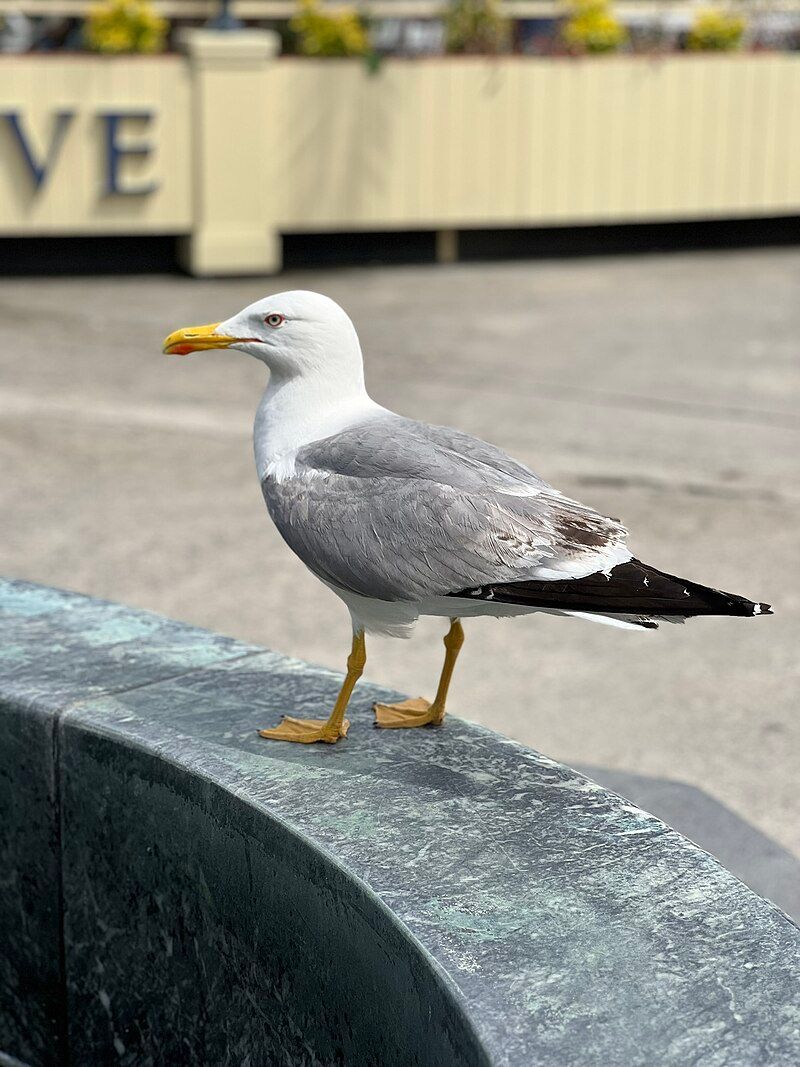
The yellow-legged gull is a large species in Europe, the Middle East, and North Africa. It is only recently that the scientific community has recognized its distinct status.
Before this, the yellow-legged gull was treated as a subspecies of the Caspian gull (Larus cachinnans) or, more broadly, as a subspecies of the herring gull (Larus argentatus).
These two species are closely related to the yellow-legged gull and share many of the same features. The yellow-legged gull is easily distinguishable with its distinct yellow legs. It also has a pale grey mantle, darker grey wings, and a black-tipped bill.
The yellow-legged gull is also more significant than the Caspian and Herring gull, making it easier to identify. The yellow-legged gull is an opportunistic feeder and will eat various food. It feeds on fish, insects, crustaceans, carrion, and garbage.
It is also known to steal food from other gulls or humans. The yellow-legged gull is a social species and can be found in large flocks. It breeds in coastal areas and can be seen nesting on rocky cliffs or the ground.
During the winter, large flocks of yellow-legged gulls can be seen in coastal areas. In conclusion, the yellow-legged gull is a large gull species found in Europe, the Middle East, and North Africa, which has only recently achieved wide recognition as a distinct species.
Its distinct yellow legs and larger size make identifying and distinguishing from other species easy. It is an opportunistic and social feeder, forming large flocks in coastal areas during winter.
| Kingdom | Animalia |
| Phylum | Chordata |
| Class | Aves |
| Order | Charadriiformes |
| Family | Laridae |
| Genus | Larus |
| Species | L. michahellis |
11. Canary Islands Chiffchaff
The Canary Islands chiffchaff is a bird species only found in the Canary Islands, Spain. It is a type of leaf warbler belonging to the family of birds called Sylviidae.
This species is sometimes called the Canary Islands chiffchaff, as the English name can be spelled with both terms. It is a small bird with bright olive-gray plumage and yellowish-white underparts.
This species is found in evergreen and pine forests and other habitats such as shrublands. It is known to feed on small insects and spiders and is not usually seen in areas with human disturbance.
The Canary Islands chiffchaff is currently listed as Least Concern on the IUCN Red List, indicating that it is not facing any significant threats.
| Kingdom | Animalia |
| Phylum | Chordata |
| Class | Aves |
| Order | Passeriformes |
| Family | Phylloscopidae |
| Genus | Phylloscopus |
| Species | P. canariensis |
12. Canary Islands Oystercatcher
The Canary Islands oystercatcher, also known as the Canarian oystercatcher or Canarian black oystercatcher, was a type of shorebird that was only found in Fuerteventura, Lanzarote, and their nearby islets in the Canary Islands of Spain.
This shorebird species was unique to the area, and its taxonomy was uncertain. Unfortunately, this species is now believed to have gone extinct, meaning it is no longer found in the wild.
This shorebird species was an essential part of the local ecosystem, playing a vital role in the environment and food chain. Its sudden disappearance is a significant loss for the area and serves as a reminder of the importance of preserving biodiversity.
The extinction of the Canary Islands oystercatcher highlights the need for conservation efforts to protect vulnerable species and maintain biodiversity. Without action, more species may become extinct, leading to further losses in the local environment.
| Kingdom | Animalia |
| Phylum | Chordata |
| Class | Aves |
| Order | Charadriiformes |
| Family | Haematopodidae |
| Genus | Haematopus |
| Species | †H. meadewaldoi |
13. Sooty Tern
The sooty tern is a species of seabird in the family Laridae. A tropical bird inhabits the oceans and only returns to land to reproduce. This particular species of bird is found in the equatorial zone, on islands throughout the region.
It is unique in its behavior, as it spends most of its life at sea and only returns to land to reproduce. The sooty tern has a unique diet, consisting mainly of small fish, crustaceans, and squid.
Flying insects and other small sea creatures supplement its diet. Its habitat is limited to tropical waters and typically avoids colder climates.
It is an integral part of the ecosystem in the tropical oceans, as it helps keep the balance of predators and prey in check.
The sooty tern is an essential species for research and conservation efforts, as it can help scientists learn more about the health of the marine environment.
Its presence in the oceans is vital to the ecosystem’s health and essential to maintaining healthy species populations.
The sooty tern is also an important species for recreational activities, such as bird-watching, as its colorful plumage makes it an attractive bird to observe.
| Kingdom | Animalia |
| Phylum | Chordata |
| Class | Aves |
| Order | Charadriiformes |
| Family | Laridae |
| Genus | Onychoprion |
| Species | O. fuscatus |
14. American Golden Plover
The American golden plover is a migratory shorebird species belonging to the Pluvialis genus.
The Latin name for this genus, Pluvialis, translates to “relating to rain,” derived from the Latin word pluvia, meaning “rain.” This name is likely a reference to the belief among many cultures that golden plovers flock when rain is coming.
Dominica is likely a reference to the island of Santo Domingo, now known as Hispaniola, located in the West Indies. The American golden plover is a medium-sized shorebird found in open grasslands, meadows, and fields.
It has a golden-brown upper body and a white belly, with wings that have a black-and-white pattern. The plover is also known for its long-distance migrations, which may span from Alaska and Canada to South America.
| Kingdom | Animalia |
| Phylum | Chordata |
| Class | Aves |
| Order | Charadriiformes |
| Family | Charadriidae |
| Genus | Pluvialis |
| Species | P. dominica |
Conclusion
Birds in Canar are a unique and diverse group of species. They come in many shapes, sizes, colors, and habitats, providing great enjoyment to birdwatchers and nature lovers alike.
They are an essential part of the area’s ecology and contribute to the health and well-being of the environment. With the proper care and protection, these birds can continue to be enjoyed for generations.